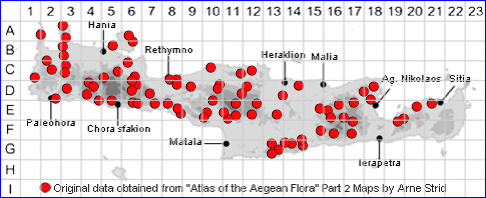
SPECIES DESCRIPTION
SILENE CRETICA
Family:- CARYOPHYLLACEAE/Sect. BEHENANTHA
Common Names:- Cretan catchfly
Synonyms:- None
Meaning:- Silene (Gr) A name used by the Greek philosopher Theophrastus for
catchfly.
Cretica (L) From Crete, Cretan.
General description:- Bright green annual, eglandular-pubescent below, with
viscid sections above.
Stems:-
1) (15-)30-60 cm, sparingly branched above, erect, puberulent at the base with
Leaves:-
Flowers:-
1) Few, in a very lax dichasia. Pink.
2) Pedicels, 2-5 times as long as the calyx.
6) Anthophore, 1.5-2.5 mm.
Fruit:-
2) Seeds 0·75-2 mm, reniform; faces slightly concave, greyish-brown.
Key features:-
1) Carpophore 1-5 mm., glabrous.
2) Calyx smooth, glabrous, usually shorter than the pedicel.
Habitat:- Grassy meadows, dry open shrubby vegetation, open woodland, olive
groves field margins. 0-1500 m.
Distribution:- Peloponnisos and Ionian Islands Italy, Balkan Peninsula, SW
Anatolia and Cyprus, casual in SW Europe Widespread on Crete.
Flowering time:- Late Mar to early June.
Photo by:- Steve Lenton

GLOSSARY OF TERMS USED
Acuminate:- Gradually narrowing to a point.
Acute:- Sharp, sharply pointed, the margins near the tip being almost straight.
Anthophore. A stalk-like extension of the receptacle on which the pistil and corolla
are borne.
Calyx:- A collective name for the sepals - the outer whorl of organs in most flowers.
Calyx-teeth:- Tip of a calyx lobe or division.
Capsule:- Dry fruit that opens when ripe. splitting from the apex to the base into
separate segments known as valves.
Carpophore:- The fruit bearing stalk A prolongation of the receptacle or floral axis
bearing the carpels or ovary.
Corolla:- A collective name for the petals.
Coronal-scale:- One of the ring of scales on th inner surface of the corolla, as at
the junction of the limb and claw in some sllene species.
Dichasium- (pl Dichasia):- Cyme with lateral branches on both sides of the main
axis.
Glabrous:- Without hairs, hairless.
Eglandular:- Without Glands.
Eglandular-Pubescent:- Covered with fine short soft glandless hairs.
Linear:- Narrow and parallel-sided. Narrow and much longer than wide, with parallel
margins.
Obcordate:- Heart-shaped, with the point of attachment at the narrow end.
Ovoid:- Egg-shaped.
Pedicel:- The stalk of an individual flower.
Petal:- The inner perianth segments when they clearly differ from the outer.
Petal-limb:- An enlarged upper part of the petals.
Petiolate:- Having a leaf stalk.
Puberulent:- Minutely pubescent, the hairs hardly visible to the naked eye.
Reniform:- Kidney-shaped, shaped like a kidney.
Sessile:- Devoid of a stalk, stalkless.
Spatulate:- Paddle-shaped, oblong with an extended basal part.
Viscid:- Sticky.